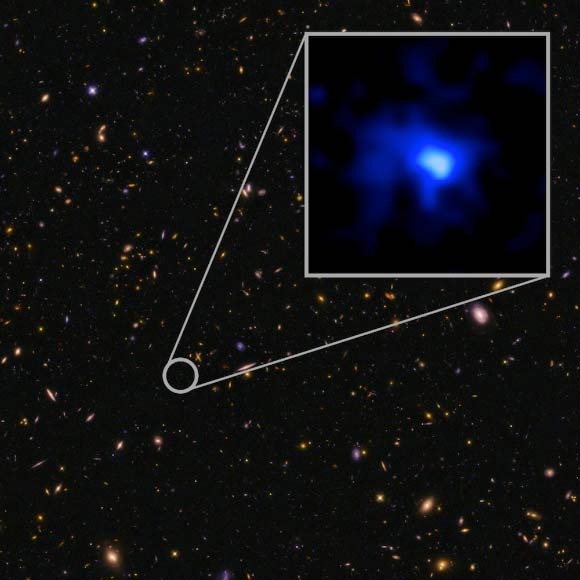An international group of astronomers led by Dr Pascal Oesch of Yale University has discovered a massive galaxy more than 13 billion years in the past and accurately measured the distance to it using the Multi-Object Spectrometer for Infra-Red Exploration (MOSFIRE) instrument on the W.M. Keck Observatory’s 10-m telescope.

This image shows EGS-zs8-1, the farthest confirmed galaxy observed to date. Image credit: NASA / ESA / P. Oesch & I. Momcheva, Yale University / 3D-HST / HUDF09 / XDF.
The galaxy, named EGS-zs8-1, is one of the brightest and most massive objects in the early Universe and was first spotted in images from NASA’s Hubble and Spitzer Space Telescopes.
“It has already built more than 15 percent of the mass of our own Milky Way today. But it had only 670 million years to do so. The Universe was still very young then,” said Dr Oesch, who is the first author on the study in the Astrophysical Journal Letters (arXiv.org preprint).
The team also determined that the galaxy is still forming stars rapidly, about 80 times faster than our Milky Way Galaxy.
“The new observations establish EGS-zs8-1 at a time when the Universe was undergoing an important change: the hydrogen between galaxies was transitioning from a neutral state to an ionized state,” said co-author Dr Rychard Bouwens of the Leiden Observatory.
“It appears that the young stars in the early galaxies like EGS-zs8-1 were the main drivers for this transition, called reionization.”
“Only a handful of galaxies currently have accurate distances measured in this very early Universe. Every confirmation adds another piece to the puzzle of how the first generations of galaxies formed in the early Universe. Only the largest telescopes are powerful enough to reach to these large distances,” added co-author Prof Pieter van Dokkum of Yale University.

EGS-zs8-1 was identified in this Hubble image of a field of galaxies in the CANDELS survey; the inset image of EGS-zs8-1 is blue, suggesting very young stars. Image credit: NASA / ESA / P. Oesch & I. Momcheva, Yale University / 3D-HST / HUDF09 / XDF.
Taken together, the new observations also pose new questions: they confirm that massive galaxies already existed early in the history of the Universe, but that their physical properties were very different from galaxies seen around us today.
Scientists now have very strong evidence that the peculiar colors of early galaxies seen in the Spitzer Space Telescope images originate from a very rapid formation of massive, young stars, which interacted with the primordial gas in these galaxies.
The MOSFIRE instrument is a highly-efficient instrument that can take images or up to 46 simultaneous spectra. Using a sensitive state-of-the-art detector and electronics system, the instrument obtains observations fainter than any other near infrared spectrograph. It is an excellent tool for studying complex star or galaxy fields, including distant galaxies in the early Universe, as well as star clusters in our own Galaxy.
“MOSFIRE allows astronomers to efficiently study several galaxies at the same time. Measuring galaxies at extreme distances and characterizing their properties will be a major goal of astronomy over the next ten years,” the astronomers said.
_____
P. A. Oesch et al. 2015. A Spectroscopic Redshift Measurement for a Luminous Lyman Break Galaxy at z = 7.730 Using Keck/MOSFIRE. ApJ 804, L30; doi: 10.1088/2041-8205/804/2/L30







